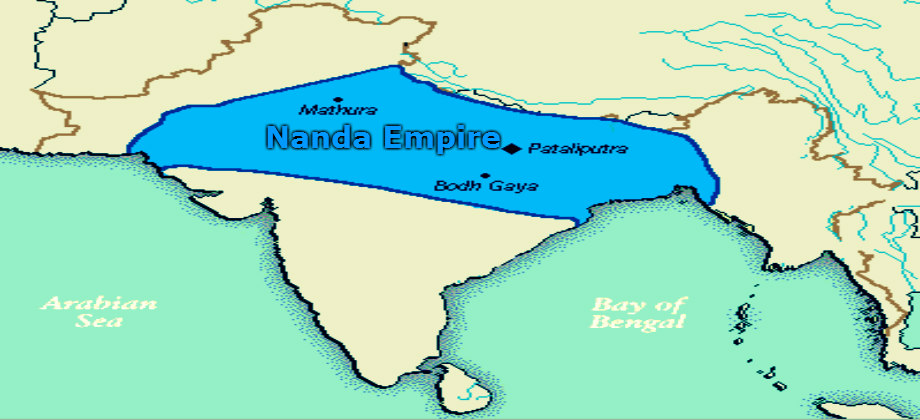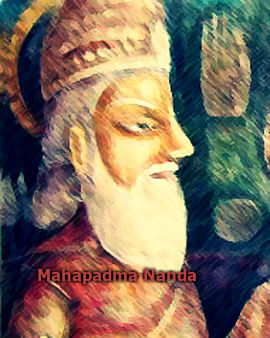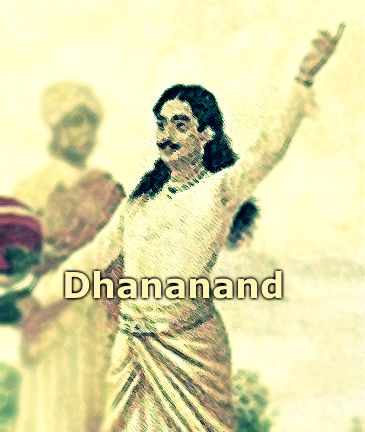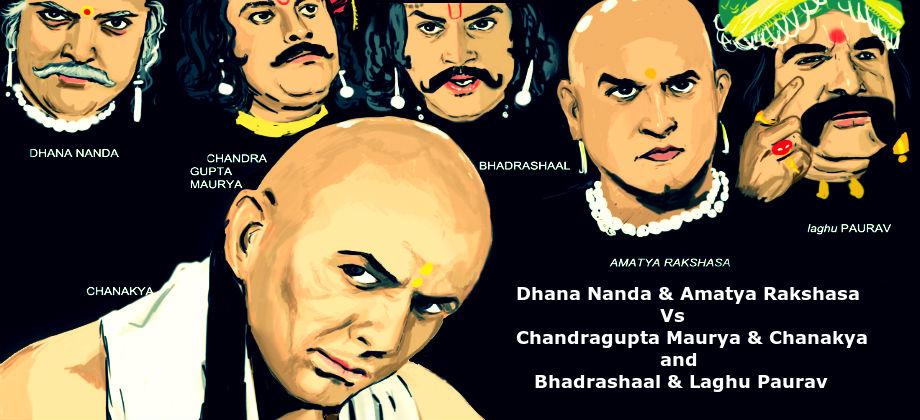 Introduction
Introduction
1. The Nanda Empire originated from the region of Magadha in ancient India during the 5th and 4th centuries BC.
2. At its greatest extent, the Nanda Empire extended from Bengal in the east, to Punjab in the west and as far south as the Vindhya Range.
3. Mahapadma Nanda, defeated the Panchalas, Kasis, Haihayas, Kalingas, Asmakas, Kurus, Maithilas, Surasenas and the Vitihotras. He expanded his territory south of the Deccan plains. Mahapadma Nanda, who died at the age of 88, was the ruler of the Nanda dynasty for all but 12 of the dynasty's 100 years.
4. The Nandas who usurped the throne of the Shishunaga dynasty were from the lineage of Yadav chief Nand Baba.
3. The Nanda Empire was later conquered by Chandragupta Maurya, who founded the Maurya Empire.
Mahapadam Nanda ( 450–362 BCE )

1. Mahapadma Nanda (450–362 BCE) was the first king of the Nanda dynasty.
2. He was the son of Mahanandin, a Yadav king of the Shishunaga dynasty.
3. Sons of Mahanandin from his other wives opposed the rise of Mahapadma Nanda, on which he eliminated all of them to claim the throne.
4. The Nandas, under Mahapadma Nanda, established the first great North Indian empire with its political centre in Magadha, which would in the following years lead to the largest empire in ancient India, to be built by the Mauryas.
5. Mahapadma Nanda vanquished the old dynasties of North, not as was customary, to extract tribute from them and to be recognized as the most powerful, the samrat or the chakravartin, but rather in order to dethrone them and declare himself as an "ekachhatra", the only emperor in the entire land.
6. The collapse of the old Kshatriya dynasties under the rigorous power politics of Mahapadma Nanda made him to be called as "The Destroyer of Kshatriyas".
7. He died at 88 years old.
8. His kingdom annexed parts of Kalinga, central India, Anga, and the upper Ganges Valley.
Dhana Nanda

1. Dhana Nanda was the last ruler of the Nanda dynasty.
2. Dhana Nanda's army, as described by Diodorus and Quintus Curtius Rufus, consisted of 200,000 infantry, 20,000 cavalry, 2,000 war chariots and 3,000 war elephants.
3. According to Plutarch however, the size of the Nanda army was even larger, numbering 200,000 infantry, 80,000 cavalry, 8,000 war chariots, and 6,000 war elephants.
4. This kingdom was vast and very strong. So strong to fear away the soldiers of Alexander who has penetrated deep in the then existing Indian Subcontinent.
5. The administration of Pataliputra under the Nanda rule, consisted of a council of ministers, the prime minister, the senapati (commander-in-chief) and a special position of Amatya; who sometime acts a chief advisor of the king and sometimes as the principal administrative head under the king.
Dhana Nanda vs Chandragupta Maurya

1. After Alexander’s departure, With the help of growing rebels Chanakya compels king of Taxila to help him and he forms a small army under the leadership of Chandragupta.
2. Chanakya’s strategies led to the assassination of the satrap of Alexander and after the death of Alexander in Greece, Chandragupta leads a force and frees all the kingdoms previously won by Alexander.
3. With the help of the his long time friend and minister in Kekaya, Chanakya makes king Porus an ally of Chandragupta and under the alliance, many kingdoms of Northern mountain countries come under the leadership of Chandragupta and with the advice of Chanakya, Chandragupta marches with that army towards Magadha to overthrow the Nanda king.
4. But Magadha was not an easy target. With exceptional military strategies, spy networks, dedicated loyal army chieftans, an honest prime minister and the ever watchful Amatya Kartikeya, popularly known as Amatya Rakshasa, it was not possible to uproot Magadha.
5. Chandragupta does fight series of wars in guerilla techniques with the Nanda army and Chanakya’s initial attempt to defeat Nanda failed and then he changed his strategies by weakening enemy at around its edges.
6. Chanakya returns to Pataliputra with a plan. He exploits the deep rooted corruption in the system led by the aging and retiring king Dhana Nanda, corrupt Commander-in-chief and jealous princes.
7. He creates a situation of civil war and the sons of the king and the commander is killed and king has to leave the city.
8. Amatya Rakshasa goes in hiding seeking plot to revenge the downfall of Nanda dynasty.
9. When Chandragupta enters Pataliputra, he faces no opposition.
10. Chanakya is appointed as new amatya and he appoints to the council all those loyal to Magadha.
11. Meanwhile, the supporter kings of Chandragupta want a share of either kingdom or wealth of Magadha. Chief among them is Laghu Paurav, the nephew of king Porus.
12. Paurav is looking for a way to remove Chandragupta to become sole ruler of Magadha. For this, he takes help of amatya Rakshasa who is living in hiding.
13. But Chanakya plays above all of them. He, with his guile and techniques, kills all the enemies of Chandragupta and compels amatya Rakshasa to surrender before him. When he does so, Chankaya humbly appoints him the amatya of Chandragupta and thus King Chandragupta is crowned as ruler of Magadha.
List of Nanda rulers
1. Mahapadma Nanda :- Established Nanda Dynasty. He destroyed all the kshatriyas of his time.
2. Pandhuka
3. Panghupati
4. Bhutapala
5. Rashtrapala
6. Govishanaka
7. Dashasidkhaka
8. Kaivarta
9. Mahendra
10. Dhana Nanda (Argames)
Nanda Empire Legacy
1. The Nandas are sometimes described as the first empire builders in the recorded history of India.
2. They inherited the large kingdom of Magadha and wished to extend it to yet more distant frontiers. To this purpose they built up a vast army, consisting of 200,000 infantry, 20,000 cavalry, 2,000 war chariots and 3,000 war elephants (at the lowest estimates).
3. According to Plutarch however, the size of the Nanda army was even larger, numbering 200,000 infantry, 80,000 cavalry, 8,000 war chariots, and 6,000 war elephants.
4. However, the Nandas never had the opportunity to see their army up against Alexander, who invaded India at the time of Dhana Nanda, since Alexander had to confine his campaign to the plains of Punjab, for his forces, frightened by the prospect of facing a formidable foe, mutinied at the Hyphasis River (the modern Beas River) refusing to march any further. This river thus marks the eastern-most extent of Alexander's conquests.
Read History Part 7 : Maurya Dynasty
Comments
comments
 Introduction
1. The Nanda Empire originated from the region of Magadha in ancient India during the 5th and 4th centuries BC.
2. At its greatest extent, the Nanda Empire extended from Bengal in the east, to Punjab in the west and as far south as the Vindhya Range.
3. Mahapadma Nanda, defeated the Panchalas, Kasis, Haihayas, Kalingas, Asmakas, Kurus, Maithilas, Surasenas and the Vitihotras. He expanded his territory south of the Deccan plains. Mahapadma Nanda, who died at the age of 88, was the ruler of the Nanda dynasty for all but 12 of the dynasty's 100 years.
4. The Nandas who usurped the throne of the Shishunaga dynasty were from the lineage of Yadav chief Nand Baba.
3. The Nanda Empire was later conquered by Chandragupta Maurya, who founded the Maurya Empire.
Mahapadam Nanda ( 450–362 BCE )
Introduction
1. The Nanda Empire originated from the region of Magadha in ancient India during the 5th and 4th centuries BC.
2. At its greatest extent, the Nanda Empire extended from Bengal in the east, to Punjab in the west and as far south as the Vindhya Range.
3. Mahapadma Nanda, defeated the Panchalas, Kasis, Haihayas, Kalingas, Asmakas, Kurus, Maithilas, Surasenas and the Vitihotras. He expanded his territory south of the Deccan plains. Mahapadma Nanda, who died at the age of 88, was the ruler of the Nanda dynasty for all but 12 of the dynasty's 100 years.
4. The Nandas who usurped the throne of the Shishunaga dynasty were from the lineage of Yadav chief Nand Baba.
3. The Nanda Empire was later conquered by Chandragupta Maurya, who founded the Maurya Empire.
Mahapadam Nanda ( 450–362 BCE )
 1. Mahapadma Nanda (450–362 BCE) was the first king of the Nanda dynasty.
2. He was the son of Mahanandin, a Yadav king of the Shishunaga dynasty.
3. Sons of Mahanandin from his other wives opposed the rise of Mahapadma Nanda, on which he eliminated all of them to claim the throne.
4. The Nandas, under Mahapadma Nanda, established the first great North Indian empire with its political centre in Magadha, which would in the following years lead to the largest empire in ancient India, to be built by the Mauryas.
5. Mahapadma Nanda vanquished the old dynasties of North, not as was customary, to extract tribute from them and to be recognized as the most powerful, the samrat or the chakravartin, but rather in order to dethrone them and declare himself as an "ekachhatra", the only emperor in the entire land.
6. The collapse of the old Kshatriya dynasties under the rigorous power politics of Mahapadma Nanda made him to be called as "The Destroyer of Kshatriyas".
7. He died at 88 years old.
8. His kingdom annexed parts of Kalinga, central India, Anga, and the upper Ganges Valley.
Dhana Nanda
1. Mahapadma Nanda (450–362 BCE) was the first king of the Nanda dynasty.
2. He was the son of Mahanandin, a Yadav king of the Shishunaga dynasty.
3. Sons of Mahanandin from his other wives opposed the rise of Mahapadma Nanda, on which he eliminated all of them to claim the throne.
4. The Nandas, under Mahapadma Nanda, established the first great North Indian empire with its political centre in Magadha, which would in the following years lead to the largest empire in ancient India, to be built by the Mauryas.
5. Mahapadma Nanda vanquished the old dynasties of North, not as was customary, to extract tribute from them and to be recognized as the most powerful, the samrat or the chakravartin, but rather in order to dethrone them and declare himself as an "ekachhatra", the only emperor in the entire land.
6. The collapse of the old Kshatriya dynasties under the rigorous power politics of Mahapadma Nanda made him to be called as "The Destroyer of Kshatriyas".
7. He died at 88 years old.
8. His kingdom annexed parts of Kalinga, central India, Anga, and the upper Ganges Valley.
Dhana Nanda
 1. Dhana Nanda was the last ruler of the Nanda dynasty.
2. Dhana Nanda's army, as described by Diodorus and Quintus Curtius Rufus, consisted of 200,000 infantry, 20,000 cavalry, 2,000 war chariots and 3,000 war elephants.
3. According to Plutarch however, the size of the Nanda army was even larger, numbering 200,000 infantry, 80,000 cavalry, 8,000 war chariots, and 6,000 war elephants.
4. This kingdom was vast and very strong. So strong to fear away the soldiers of Alexander who has penetrated deep in the then existing Indian Subcontinent.
5. The administration of Pataliputra under the Nanda rule, consisted of a council of ministers, the prime minister, the senapati (commander-in-chief) and a special position of Amatya; who sometime acts a chief advisor of the king and sometimes as the principal administrative head under the king.
Dhana Nanda vs Chandragupta Maurya
1. Dhana Nanda was the last ruler of the Nanda dynasty.
2. Dhana Nanda's army, as described by Diodorus and Quintus Curtius Rufus, consisted of 200,000 infantry, 20,000 cavalry, 2,000 war chariots and 3,000 war elephants.
3. According to Plutarch however, the size of the Nanda army was even larger, numbering 200,000 infantry, 80,000 cavalry, 8,000 war chariots, and 6,000 war elephants.
4. This kingdom was vast and very strong. So strong to fear away the soldiers of Alexander who has penetrated deep in the then existing Indian Subcontinent.
5. The administration of Pataliputra under the Nanda rule, consisted of a council of ministers, the prime minister, the senapati (commander-in-chief) and a special position of Amatya; who sometime acts a chief advisor of the king and sometimes as the principal administrative head under the king.
Dhana Nanda vs Chandragupta Maurya
 1. After Alexander’s departure, With the help of growing rebels Chanakya compels king of Taxila to help him and he forms a small army under the leadership of Chandragupta.
2. Chanakya’s strategies led to the assassination of the satrap of Alexander and after the death of Alexander in Greece, Chandragupta leads a force and frees all the kingdoms previously won by Alexander.
3. With the help of the his long time friend and minister in Kekaya, Chanakya makes king Porus an ally of Chandragupta and under the alliance, many kingdoms of Northern mountain countries come under the leadership of Chandragupta and with the advice of Chanakya, Chandragupta marches with that army towards Magadha to overthrow the Nanda king.
4. But Magadha was not an easy target. With exceptional military strategies, spy networks, dedicated loyal army chieftans, an honest prime minister and the ever watchful Amatya Kartikeya, popularly known as Amatya Rakshasa, it was not possible to uproot Magadha.
5. Chandragupta does fight series of wars in guerilla techniques with the Nanda army and Chanakya’s initial attempt to defeat Nanda failed and then he changed his strategies by weakening enemy at around its edges.
6. Chanakya returns to Pataliputra with a plan. He exploits the deep rooted corruption in the system led by the aging and retiring king Dhana Nanda, corrupt Commander-in-chief and jealous princes.
7. He creates a situation of civil war and the sons of the king and the commander is killed and king has to leave the city.
8. Amatya Rakshasa goes in hiding seeking plot to revenge the downfall of Nanda dynasty.
9. When Chandragupta enters Pataliputra, he faces no opposition.
10. Chanakya is appointed as new amatya and he appoints to the council all those loyal to Magadha.
11. Meanwhile, the supporter kings of Chandragupta want a share of either kingdom or wealth of Magadha. Chief among them is Laghu Paurav, the nephew of king Porus.
12. Paurav is looking for a way to remove Chandragupta to become sole ruler of Magadha. For this, he takes help of amatya Rakshasa who is living in hiding.
13. But Chanakya plays above all of them. He, with his guile and techniques, kills all the enemies of Chandragupta and compels amatya Rakshasa to surrender before him. When he does so, Chankaya humbly appoints him the amatya of Chandragupta and thus King Chandragupta is crowned as ruler of Magadha.
List of Nanda rulers
1. Mahapadma Nanda :- Established Nanda Dynasty. He destroyed all the kshatriyas of his time.
2. Pandhuka
3. Panghupati
4. Bhutapala
5. Rashtrapala
6. Govishanaka
7. Dashasidkhaka
8. Kaivarta
9. Mahendra
10. Dhana Nanda (Argames)
Nanda Empire Legacy
1. The Nandas are sometimes described as the first empire builders in the recorded history of India.
2. They inherited the large kingdom of Magadha and wished to extend it to yet more distant frontiers. To this purpose they built up a vast army, consisting of 200,000 infantry, 20,000 cavalry, 2,000 war chariots and 3,000 war elephants (at the lowest estimates).
3. According to Plutarch however, the size of the Nanda army was even larger, numbering 200,000 infantry, 80,000 cavalry, 8,000 war chariots, and 6,000 war elephants.
4. However, the Nandas never had the opportunity to see their army up against Alexander, who invaded India at the time of Dhana Nanda, since Alexander had to confine his campaign to the plains of Punjab, for his forces, frightened by the prospect of facing a formidable foe, mutinied at the Hyphasis River (the modern Beas River) refusing to march any further. This river thus marks the eastern-most extent of Alexander's conquests.
Read History Part 7 : Maurya Dynasty
1. After Alexander’s departure, With the help of growing rebels Chanakya compels king of Taxila to help him and he forms a small army under the leadership of Chandragupta.
2. Chanakya’s strategies led to the assassination of the satrap of Alexander and after the death of Alexander in Greece, Chandragupta leads a force and frees all the kingdoms previously won by Alexander.
3. With the help of the his long time friend and minister in Kekaya, Chanakya makes king Porus an ally of Chandragupta and under the alliance, many kingdoms of Northern mountain countries come under the leadership of Chandragupta and with the advice of Chanakya, Chandragupta marches with that army towards Magadha to overthrow the Nanda king.
4. But Magadha was not an easy target. With exceptional military strategies, spy networks, dedicated loyal army chieftans, an honest prime minister and the ever watchful Amatya Kartikeya, popularly known as Amatya Rakshasa, it was not possible to uproot Magadha.
5. Chandragupta does fight series of wars in guerilla techniques with the Nanda army and Chanakya’s initial attempt to defeat Nanda failed and then he changed his strategies by weakening enemy at around its edges.
6. Chanakya returns to Pataliputra with a plan. He exploits the deep rooted corruption in the system led by the aging and retiring king Dhana Nanda, corrupt Commander-in-chief and jealous princes.
7. He creates a situation of civil war and the sons of the king and the commander is killed and king has to leave the city.
8. Amatya Rakshasa goes in hiding seeking plot to revenge the downfall of Nanda dynasty.
9. When Chandragupta enters Pataliputra, he faces no opposition.
10. Chanakya is appointed as new amatya and he appoints to the council all those loyal to Magadha.
11. Meanwhile, the supporter kings of Chandragupta want a share of either kingdom or wealth of Magadha. Chief among them is Laghu Paurav, the nephew of king Porus.
12. Paurav is looking for a way to remove Chandragupta to become sole ruler of Magadha. For this, he takes help of amatya Rakshasa who is living in hiding.
13. But Chanakya plays above all of them. He, with his guile and techniques, kills all the enemies of Chandragupta and compels amatya Rakshasa to surrender before him. When he does so, Chankaya humbly appoints him the amatya of Chandragupta and thus King Chandragupta is crowned as ruler of Magadha.
List of Nanda rulers
1. Mahapadma Nanda :- Established Nanda Dynasty. He destroyed all the kshatriyas of his time.
2. Pandhuka
3. Panghupati
4. Bhutapala
5. Rashtrapala
6. Govishanaka
7. Dashasidkhaka
8. Kaivarta
9. Mahendra
10. Dhana Nanda (Argames)
Nanda Empire Legacy
1. The Nandas are sometimes described as the first empire builders in the recorded history of India.
2. They inherited the large kingdom of Magadha and wished to extend it to yet more distant frontiers. To this purpose they built up a vast army, consisting of 200,000 infantry, 20,000 cavalry, 2,000 war chariots and 3,000 war elephants (at the lowest estimates).
3. According to Plutarch however, the size of the Nanda army was even larger, numbering 200,000 infantry, 80,000 cavalry, 8,000 war chariots, and 6,000 war elephants.
4. However, the Nandas never had the opportunity to see their army up against Alexander, who invaded India at the time of Dhana Nanda, since Alexander had to confine his campaign to the plains of Punjab, for his forces, frightened by the prospect of facing a formidable foe, mutinied at the Hyphasis River (the modern Beas River) refusing to march any further. This river thus marks the eastern-most extent of Alexander's conquests.
Read History Part 7 : Maurya Dynasty

